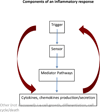Monogenic autoinflammatory diseases: disorders of amplified danger sensing and cytokine dysregulation
- PMID: 24182851
- PMCID: PMC3888876
- DOI: 10.1016/j.rdc.2013.08.001
Monogenic autoinflammatory diseases: disorders of amplified danger sensing and cytokine dysregulation
Abstract
The pathogenesis of monogenic autoinflammatory diseases converges on the presence of exaggerated immune responses that are triggered through activation of altered pattern recognition receptor (PRR) pathways and result in cytokine/chemokine amplification loops and the inflammatory clinical phenotype seen in autoinflammatory patients. The PRR response can be triggered by accumulation of metabolites, by mutations in sensors leading to their constitutive overactivation, or by mutations in mediator cytokine pathways that lead to amplification and/or inability to downregulate an inflammatory response in hematopoietic and/or nonhematopoietic cells. The study of the pathogenesis of sterile inflammation in patients with autoinflammatory syndromes continues to uncover novel inflammatory pathways.
Keywords: Autoinflammatory diseases; Chronic atypical neutrophilic dermatosis with lipodystrophy and elevated temperature (CANDLE); Cryopyrin-associated periodic syndrome (CAPS); Deficiency of the IL-1 receptor antagonist (DIRA); Inflammasome; Intracellular pattern recognition receptors (PRR); Neonatal-onset multisystem inflammatory disease (NOMID); Proteasome-associated autoinflammatory syndrome (PRAAS).
Published by Elsevier Inc.
Figures



References
-
- Consortium FF. A candidate gene for familial Mediterranean fever. Nat Genet. 1997;17:25–31. - PubMed
-
- Consortium TIF. Ancient missense mutations in a new member of the RoRet gene family are likely to cause familial Mediterranean fever. Cell. 1997;90:797–807. - PubMed
-
- McDermott MF, Aksentijevich I, Galon J, McDermott EM, Ogunkolade BW, Centola M, Mansfield E, Gadina M, Karenko L, Pettersson T, McCarthy J, Frucht DM, Aringer M, Torosyan Y, Teppo AM, Wilson M, Karaarslan HM, Wan Y, Todd I, Wood G, Schlimgen R, Kumarajeewa TR, Cooper SM, Vella JP, Amos CI, Mulley J, Quane KA, Molloy MG, Ranki A, Powell RJ, Hitman GA, O'Shea JJ, Kastner DL. Germline mutations in the extracellular domains of the 55 kDa TNF receptor, TNFR1, define a family of dominantly inherited autoinflammatory syndromes. Cell. 1999;97:133–144. - PubMed
-
- Drenth JP, Cuisset L, Grateau G, Vasseur C, van de Velde-Visser SD, de Jong JG, Beckmann JS, van der Meer JW, Delpech M. Mutations in the gene encoding mevalonate kinase cause hyper-IgD and periodic fever syndrome. International Hyper-IgD Study Group. Nat Genet. 1999;22:178–181. - PubMed
Publication types
MeSH terms
Substances
Grants and funding
LinkOut - more resources
Full Text Sources
Other Literature Sources
Miscellaneous

